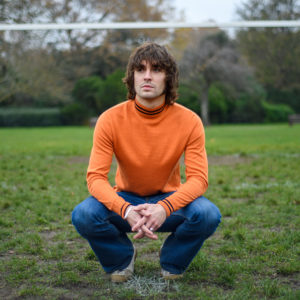
It was that turn wasn’t it? Versus Sweden in the 1974 World Cup. One second, he was there and the next, well, he was gone. Within days we were all trying to emulate the man and mainly falling arse over teacup. For the majority, it put his name on the footballing map and there he stayed for many years to come.
He was born Hendrik Johannes Cruijff on April 25, 1947, in Amsterdam, the second son of Hermanus Cruijff and his wife Petronella, known affectionately as Nel but we all knew him as Johan Cruyff and he rose to become one of the most iconic and influential figures in the history of football, renowned for his exceptional skill, athleticism, vision and tactical brilliance. Cruyff left a lasting mark on the sport as a player at first, then manager, and football philosopher. He simply loved playing football from a young age and had an innate talent that quickly became evident to all those who saw him play. Growing up in a working-class neighbourhood in Amsterdam, he honed his skills playing street football, developing the close ball control and improvisational abilities that would define his playing style.
In 1957 aged 10, Cruyff joined the youth team of his local club, Ajax Amsterdam. Under the guidance of influential coach Rinus Michels, Cruyff’s talent blossomed. Michels would go on to play a pivotal role in Cruyff’s career, both as a player and later as a manager. Johan made his debut for the club in 1964, and it wasn’t long before he became the club’s star player. He helped lead Ajax to a period of domestic and European dominance in the early 1970s, winning 8 Eredivisie titles and 3 consecutive European Cups – now known as the UEFA Champions League – from 1971 to 1973. In 329 matches for Ajax, he scored 257 goals and was credited with 170 assists.
Cruyff’s style of play was revolutionary. He was a forward who possessed not only incredible technical skills but also an innate footballing intelligence. He had an uncanny ability to read the game, anticipate movements, and create opportunities for himself and his teammates. His dribbling, vision, and precise passing made him a complete player. One of Cruyff’s most significant contributions to the game was his role in popularising what became known as Total Football.
This tactical philosophy, developed by Michels, emphasised fluid positional play, versatility among players, and constant movement to maintain control of the ball. Perhaps above all, Cruyff epitomised these principles and became the face of that era. The football world acknowledged his talents, and he won the Ballon d’Or three times, in 1971, ‘73, and ’74.
In 1973, he made a high-profile move to Barcelona for around $2million, a world record fee at the time.
‘I remember my move to Spain was quite controversial. The president of Ajax wanted to sell me to Real Madrid. Barcelona weren’t at the same level as Madrid football wise, but it was a challenge to play for a Catalan club. Barcelona was more than a club.’
Once there he continued to dazzle crowds with his footballing brilliance. His impact on the club was profound, as he helped lead Barcelona to their first La Liga title in 14 years during the 1973-74 season.
During this period, Cruyff also made a significant impact on the international stage, winning 48 caps for the Netherlands national team and scoring 33 goals. He played a pivotal role in their run to the 1974 FIFA World Cup final. The Dutch team were captained by Cruyff, his famous number 14 on his jersey. Managed by Michels, they played an innovative and attractive brand of football that captured the imagination of fans worldwide. Despite losing to West Germany in the final, Cruyff’s influence on the tournament was immense, earning him the Golden Ball award as the tournament’s best player.
The Adidas shirt he wore for the national side at that World Cup had 2 stripes down its sleeves, instead of the standard 3 . This was due to Cruyff already having a sponsorship deal with sportswear rivals Puma, so a compromise had to be found. The memorable moment mentioned earlier, which became known by the footballing World as the Cruyff Turn, came during the opening match of the World Cup in ’74 and remains an iconic moment in football history. The Dutch then finished third in the European Championship of 1976, before Cruyff refused to play in the 1978 World Cup, due to a kidnapping attempt in Barcelona.
‘Someone put a rifle at my head and tied me up and tied up my wife in front of the children at our flat in Barcelona. The children were going to school accompanied by the police. The police slept in our house for three or four months. I was going to matches with a bodyguard. All these things change your point of view towards many things. We wanted to stop this and be a little more sensible. It was the moment to leave football and I couldn’t play in the World Cup after this. To play a World Cup you have to be 200% okay, there are moments when there are other values in life.’
Following a brief retirement, he came back and moved his family to the USA where he resumed playing.
‘I had lost millions in pig-farming and that was the reason I decided to become a footballer again. It was wrong, a mistake, to quit playing at 31 with the unique talent I possessed. Starting from zero in America, many miles away from my past, was one of the best decisions I made. There I learned how to develop my uncontrolled ambitions, to think as a coach and about sponsorship.’
He signed with the Los Angeles Aztecs in 1979, then moved to the Washington Diplomats in 1980 . He then returned to Ajax and they became league champions in 1981–82 and 83 seasons. The following year, Ajax decided not to renew his contract, so he signed for bitter rivals Feyenoord instead and won the title there too in 1984, alongside a young Ruud Gullit.
He then went back and managed Ajax from 1986, winning the European Cup Winners Cup in 1987, before he joined Barcelona in 1988 as its manager where began implementing his footballing philosophy, later known as Tiki-Taka.
At the Nou Camp. he emphasised youth development, ball possession, and attacking football, principles that continue to define Barcelona’s playing style to this day. Under Cruyff’s management, he firmly established the club as a dominant force in Spanish and European football and alongside the local talent he already had, he brought in players such as Pep Guardiola, Ronald Koeman, Michael Laudrap, Gheorghe Hagi, Romario and Hristo Stoichkov.
In his time there, he won the 1989 European Cup Winners Cup, The La Liga title from 1991 to 1994, the Copa del Rey in 1990, and the European Cup and the European Super Cup in 1992, totalling 11 trophies in all. He then fell out with the chairman Nunez and was sacked.
His tenure however had laid the foundation for Barcelona’s future success under later managers like Pep Guardiola, who Cruyff had a hand in appointing, thus continuing to build on the Cruyffian footballing philosophy.
‘The biggest test for a coach at a team like Barça is the strength to make decisions and the ability to talk to the press, because they don’t help and you have to manage that. After that, it’s easy for those who know football. But there aren’t many who know.’
In his personal life, Cruyff had met his future wife, Diana Margaretha Danny Coster in 1967, and they married in 1968, with Cruyff then aged 21 and his bride 19. Her father Cor Coster, was also Cruyff’s agent. They had 3 children together, Chantal 1970, Susila 1972 and Jordi in 1974, named after the patron saint of Catalonia, St Jordi, and who would go on to play for Barcelona and Manchester United, among others
In 1991, Johan Cruyff faced a significant personal challenge when he was diagnosed with lung cancer, attributed to a lifetime of smoking 20 cigarettes a day. He underwent successful surgery to remove a tumour, and the experience served as a turning point in his life. He quit smoking and became an advocate for a healthy lifestyle. Cruyff’s resilience in the face of this health scare was characteristic of his determination both on and off the field. He continued to be involved in football, providing commentary and analysis on matches and contributing to the development of youth academies and coaching programs.
Sadly, his lung cancer returned, and he died on March 24, 2016, at the age of 68. He was cremated in Barcelona. His death was met with an outpouring of tributes from the footballing world, highlighting the profound impact he had on the sport.
‘I played 18 years in top football and 17 times for Sweden but that moment against Cruyff was the proudest moment of my career. I thought I’d win the ball for sure, but he tricked me. I was not humiliated. I had no chance. Cruyff was a genius.’ – Swedish defender Jan Olsson, the victim of the ‘Cruyff turn.’
‘His intelligence off the field as well as on it was quite remarkable. How well I remember seeing Cruyff surrounded by journalists from all over the world in 1978 to whose questions he replied almost casually in a multiplicity of languages. Not only Dutch, but English, French, Spanish and German.’ – Brian Glanville.
‘When players like Bale and Ronaldo are worth around €100 million, Johan would go in the billions!’ – Franz Beckenbauer.
Last word to the man himself.
‘In Spain all 22 players make the sign of the cross before a game; if it worked, every game would be a tie. Every trainer talks about movement, about running a lot. I say don’t run so much. Football is a game you play with your brain. You have to be in the right place at the right moment, not too early, not too late.
Playing football is very simple but playing simple football is the hardest thing there is.’
The Mumper of SE5
Read The Mumper’s other weekly musings on ‘The Speakeasy’ blog page
ART GALLERY CLOTHING
Knitwear – Use Promo Code agc10spk for a 10% Discount
THE SPEAKEASY VOLUME 3 – AVAILABLE NOW
THE SPEAKEASY Volume Three by Mark Baxter (The Mumper)
Illustrations by Lewis Wharton
Foreword by Eddie Piller
Available to ORDER exclusively in the Art Gallery Clothing SHOP
JOIN US
Sign up to our newsletter and receive an exclusive promo code, latest news & Art Gallery Clothing offers.




